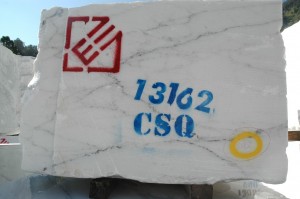Up in the mountains of Carrara, while the marble was still at the quarry, Michelangelo would have cut his original block down to size. This was needed to reduce weight and transportation cost. Today, this is less important, and the extra stone that will be feathered away can be used for smaller carvings.
In my last post I probed my block looking for flaws that could prove disastrous if ignored. Now that I have settled on a safe layout for my Pieta, I can continue to cut the extra stone away. Ideally, this will conserve large pieces for later… no sense reducing half the original weight into chips and chunks of expensive gravel.
So once again I follow the same procedure… Saw, Hammer & Feather along my demarcation lines.







